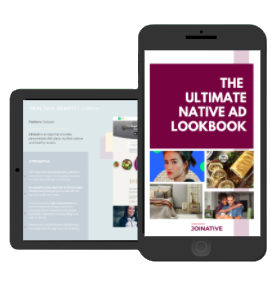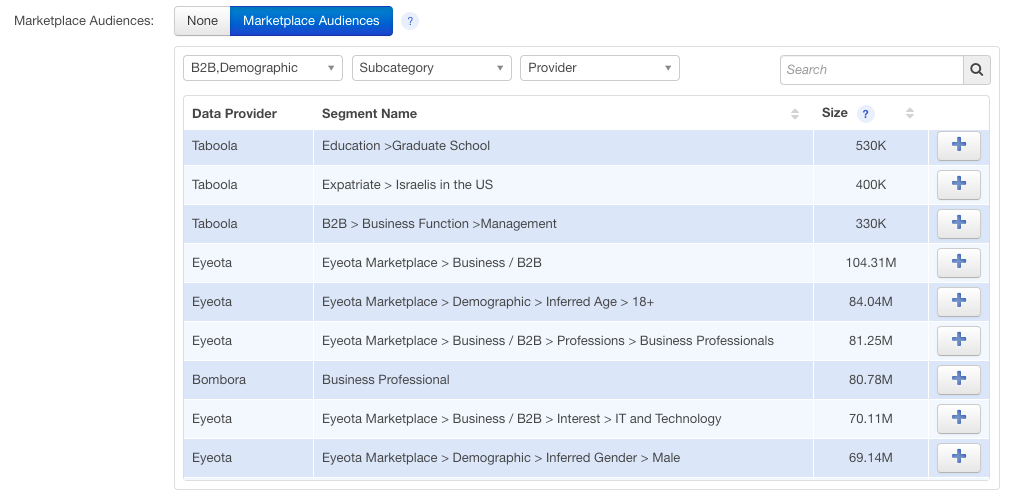Taboola for Advertisers: Complete Guide - AdsHeavy Native Ads
Taboola for Advertisers: The Step-by-Step Guide
When you’re just about to start with native advertising, Taboola is the first platform that comes to mind: it’s the most popular native advertising platform that keeps growing rapidly. It can be found in every list of the best native ad networks, and you might have noticed its widely spread ads on your favorite websites.
Its popularity is certainly understandable – with 13.96% of the market share, Taboola’s ads reach over 1.4 billion unique users per month. Partnering with the world’s top publishers, such as NBC News, Daily Mail, The Weather Channel, EuroSport, and others, Taboola drives high-quality traffic to advertisers’ websites.
We prepared the beginner’s guide to setting up the first Taboola campaign for those who found all of Taboola’s benefits appealing enough and finally decided to get started with native ads on this platform.
What is Taboola
Taboola is the world’s most popular content discovery & native advertising platform for publishers and advertisers. Its native ads appear within customizable widgets within the feed or at the bottom, top or side of blog posts.
Examples


Here are some nice-to-know statistics about Taboola:
- 56% of websites that use content curation technologies advertise with Taboola.
- 1,783 websites from the world’s top 10K websites by traffic are Taboola’s customers.
- Taboola works with more than 10,000 premium publishers and brands.
- Taboola’s native ads reach 44.5% of the world’s Internet population.
How it works
In the years since being founded in 2007, Taboola has become one of the main providers of sponsored content on popular websites.
The process of native advertising on Taboola is simple and straightforward:
-
Advertisers create content, specify the sums they’re ready to pay per click, define the type of audience they want to reach, and wait for their native ads to bring traffic to their landing pages.
-
Publishers put a Taboola widget on their site and get paid for displaying paid content.
-
Taboola’s interface connects advertisers and publishers, ensures ads are well-crafted and facilitates the functioning of the marketplace.
How to create your first campaign on Taboola
Once you enter your data into Taboola’s signup form, you are automatically directed to the process of the creation of your first campaign.

Select the right content
What type of content are you going to promote? Is it informative, entertaining, or educational? Is it a blog post, video, or photo gallery? Why do you think it might be appealing to your target audience?
These are the questions you should answer before you start. Like any other marketing method, native advertising is effective only when the advertised product has some value for the audience.
You might also want to have a look at the chart that displays the difference in content types’ performance:

You can see that visual content results in the highest CTRs. The fact to consider for your next campaign, right?
Ad content
Unlike Yahoo Gemini, where you should add creative assets at the last stage of campaign creation, Taboola offers you to enter branding text, title, target URL, and add images on the first step.
Whether native advertising will be effective for you or not highly depends on the way your ad looks. If you manage to catch your audience’s attention, you’re halfway to success.
Title
You have a maximum of 60 characters to communicate the main idea of the content you promote and convince users this is the content they want to check out right now.
Use power words. There are words that help writers impress their audience, get them excited, or encourage them to keep reading. These words might include emotional trigger words, such as joyful, astonishing, abusive, anxious, mind-blowing, etc.
Numbers & statistics. These are not exactly words, but they’ll definitely help you boost your persuasiveness.
Be precise. Compare the following two titles: ‘How to climb the corporate ladder’ and ‘Amazon CMO shares tips to build a successful career,’ which one would you rather click on?
Thumbnail
The image is the first thing users see. Use high-quality and eye-catching thumbnails to get noticed.
PRO TIP: Taboola provides insights on the most successful elements of native ads depending on your product or service category, your target language, country, and platform.
For better results, we recommend that you test a lot of different combinations of titles and thumbnails in your campaigns.
35+ Amazing Native Ad Examples
Download our free native ad lookbook and see how effective campaigns are built.

Marketing objective
Next, you need to define your campaign objective. There are five options you can choose from:
- Lead Generation
- Online Purchases
- Brand Awareness
- Web Engagement
- Mobile App Installs
Your KPIs will highly depend on the decision you’ll make at this stage.
Targeting
While you’re only creating your first campaign, you have two targeting options: by country and by device type. But once you complete the sign-up procedure (after you enter your billing details), you’ll be provided with more advanced targeting options, including targeting based on the operating system or targeting based on a variety of types of audiences: Campaign Clickers, My Audiences, Lookalike Audiences, and Marketplace Audiences.
With the Campaign Clickers option, you can retarget people who have clicked through your ads from other campaigns within a specific timeframe.
My Audiences – this targeting option allows you to retarget your website visitors after you set up Taboola pixel.
Lookalike targeting can be used to expand your reach and target new people likely to be interested in your business because they resemble your clients.
Marketplace Audiences provides audience targeting options based on your audience’s interests, behavior, demographics, and buying intent.

A few things to consider:
-
Even though you might think you know your audience inside out, get ready to keep testing. In a week, you might be surprised by the demographics of users who responded to your ads.
-
Split your campaigns by audience segments to adjust campaign settings (e.g. CPC, creatives, etc.) for every segment.
-
Mind that when you select audiences from several audience types at once, you’ll limit your reach significantly.
Campaign scheduling
Like other native ads networks, Taboola lets you select the timeframe you want your campaign to be live. Alternatively, you can specify when you don’t want your ads to be displayed.
Of course, the ideal targeting time mostly depends on your location. On this chart presented by Taboola, you see how users’ behavior differs depending on the day of the week:

Bidding strategy & budget
Taboola offers two main bidding strategies: Fixed Bid and Smart Bid. While you’re most likely to be familiar with the first strategy, let’s look into how the Smart Bid strategy works.

Smart Bid is the bidding strategy that lets you maximize conversions based on your marketing objective. Once you decide on your baseline campaign bid, Smart bid optimizes bids using historic data to evaluate how likely specific impressions are to capture conversions. If you leverage Smart Bid strategy, the platform will keep A/B testing and comparing the automated bidding strategy with the fixed bidding strategy in real time. Smart Bid will only be utilized if it outperforms Fixed Bid.
You should also either define the spending limit on a per month basis or set the budget for the entire duration of your campaign.
One more important step is deciding on the pace of the whole campaign. You can go with a recommended for most advertisers Balanced Pacing that means Taboola will run your campaign evenly throughout the month. If you select Accelerated Pacing, your campaign will pace in the way for your budget to be spent as quickly as possible. With Strict Pacing, you’ll need to specify the minimum sum you’re ready to spend per day. Remember that the actual daily spend can be twice as much as the sum you entered. If you don’t want to spend the entire monthly budget in a couple of days, we highly recommend indicating your daily budget.
Monitor your campaign & optimize its performance
After you launch your first campaign, Taboola’s reports will provide you with multiple types of performance reports that you can filter by specific criteria. Each of the following reports will provide you with a different view of your campaign information:
- Viewing data by time
- Viewing data by location
- Viewing data by platform
- Viewing data by campaign item
- Viewing data by hour or day, etc.
For any report, you’ll see the following metrics:
- Impressions
- Viewable impressions (tracked each time your ad is on the screen for at least 1 second)
- CTR
- Viewable CTR
- Clicks
- Average CPC
- CPM (cost per one thousand impressions)
- Viewable CPM
- Conversion rate
- Conversions
- CPA
- Views
- Completed views (for videos)
To set up accurate conversion tracking and set up Taboola Pixel, follow Taboola’s instructions. If you opt for measuring your campaign performance with Google Analytics, don’t forget to create and add proper UTM parameters.
Do you want to get more informative reports on Taboola campaign performance? With Native Pro, you get access to insightful reporting dashboards, manage your Taboola and Outbrain performance data from one interface, receive performance alerts, and more. Book a free demo to learn how to make the most of your native ads with Native Pro.
What’s next?
Every advertising method requires measuring performance in order to optimize your campaigns toward higher ROI. Native advertising is not an exception. To improve your performance and build a successful native advertising campaign, you’ll need to spend time developing your creatives, adjusting your CPC controls, using different targeting options, and never stop testing.
At Joinative, we want to help you make this path smoother. Regardless if you’re starting to explore native advertising or looking for a better way to manage and optimize your campaigns. Joinative will help you build an effective strategy to achieve your goals and show you how you can keep managing and improving your campaigns. Read more about our services, our native ads management platform, or just get in touch with us directly.
Whether you’re a publisher or advertiser, there’s something for everyone with AdsHeavy.


